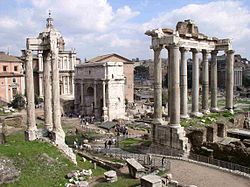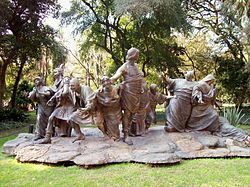Saturnalia
Saturnalia was an ancient Roman festival. It honoured of the god Saturn. Originally, Saturnalia was held on 17 December of the Julian calendar. Later it lasted through 23 December.
The holiday was celebrated with a public banquet and a sacrifice at the Temple of Saturn in the Roman Forum. There was private gift-giving, continual partying, and a carnival atmosphere. Gambling was permitted, and masters served their slaves.[1] A common custom was electing a "King of the Saturnalia". The poet Catullus called it "the best of days".[2]
Saturnalia Media
Ancient Greek painting signed by "Alexander of Athens", discovered in Herculaneum, showing five women playing knucklebones, a game which was played during the Attic holiday of Kronia
Ruins of the Temple of Saturn (eight columns on right) in Rome, traditionally said to have been constructed in 497 BC[3][4]
During Saturnalia, the Romans offered oscillum, effigies of human heads, in place of real human heads.
Dice players in a wall painting from Pompeii
Ave, Caesar! Io, Saturnalia! (1880) by Lawrence Alma-Tadema. The painting's title draws a comparison between the spontaneous declaration of Claudius as the new emperor by the Praetorian Guard after the assassination of Caligula and the election of a Saturnalicius princeps.
Drawing from the Chronography of 354 (a calendar of the year 354 produced by Filocalus) depicting the month of December, with Saturnalian dice on the table and a mask (oscilla) hanging above
Saturnalia (1909) by Ernesto Biondi, in the Buenos Aires Botanical Gardens
References
- ↑ Miller, John F. "Roman Festivals," in The Oxford Encyclopedia of Ancient Greece and Rome (Oxford University Press, 2010), p. 172.
- ↑ Catullus 14.15 (optimo dierum), as cited by Mueller 2010
- ↑ Palmer 1997.
- ↑ Mueller 2010.








